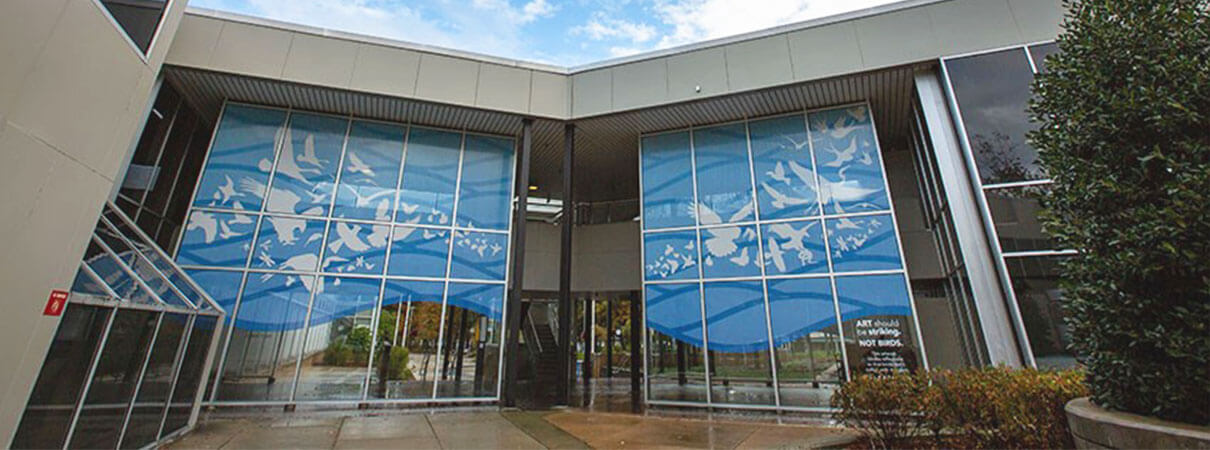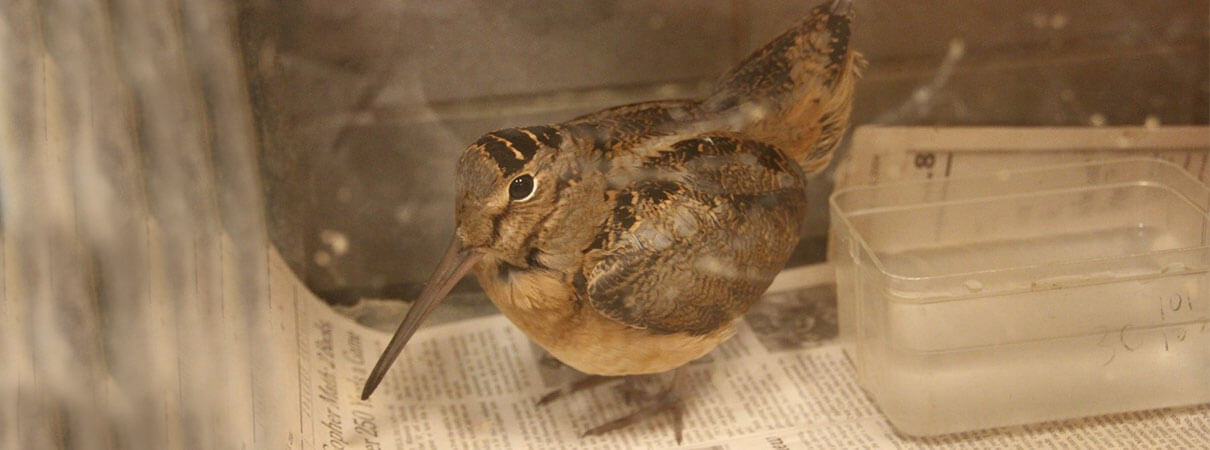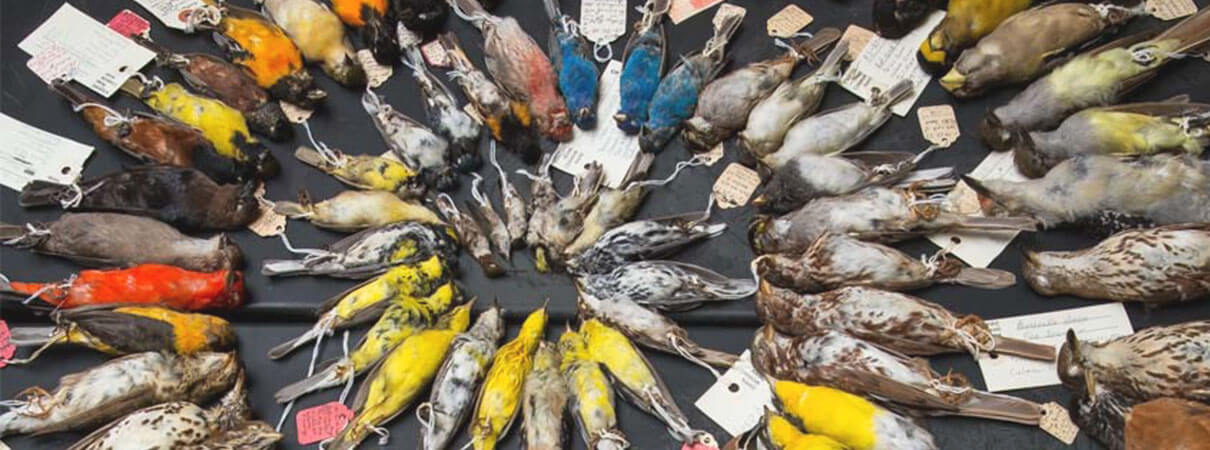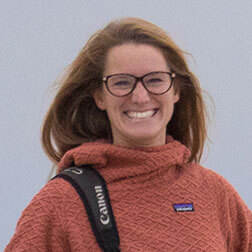At Stockton University, Students and Staff Collaborate to Prevent Bird Collisions
Art Should Be Striking…Not Birds
A flock of birds has taken flight in artistic form across a glass breezeway on Stockton University's campus in New Jersey. The winged silhouettes serve two purposes: They warn migrating birds to steer clear of the windows and educate viewers about the unseen threat buildings pose to birds in flight.
The mural features local biodiversity from hummingbirds and herons to Ospreys and songbirds, printed on sheets of vinyl film that block reflections of sky and forest.
The story of this bird-saving art began decades ago, when environmentally conscious students noticed dead and injured birds dotting the perimeters of campus buildings. And it ends with Stockton turning a conservation solution into art.
Click video above to see how Stockton University prevented bird collisions.
A Senior Project with a Lasting Impact
"It all started when I found injured birds that had crashed against windows,” explains Jeffrey Sherman, now a retired high school science teacher in California, remembering a report he wrote for his senior project in a class called “Birds and Architecture” in 1978.
With a map of the campus, Sherman set out to identify where and when birds struck buildings, and to note the species impacted. Fellow students John Rokita and Lester Block were also aware of the problem, so the three made a schedule of shifts to monitor the campus for bird strikes.
Today, there are resources and guidelines available from American Bird Conservancy and U.S. Fish and Wildlife Service, but there were no instructions then, according to Sherman, and “the effectiveness of stuffed owls and hawk decals was not great.”
Professors Mark and Martha Pokras ran an avian rehabilitation center, where Sherman, Rokita, and Block volunteered to help injured and window-struck birds recover and, if possible, be returned to the wild.
The problem persisted after the students graduated, but so did the interest in finding a solution.
Rokita and Block, who now work at Stockton in the School of Natural Sciences and Mathematics, didn't forget Sherman's report.

Stockton University's bird-friendly mural. Photo by Susan Allen
An Unexpected Lesson
A chunky bird with a beak nearly as long as its body stared up at me from the vestibule floor.
I never expected to see my first American Woodcock on my way into work at Stockton back in November 2010, but there it sat, huddled in a corner, stranded between two doors, looking lost and terrified.
I dug my phone from my purse and called the person everyone on campus calls when they find a bird or other creature out of place or injured — John Rokita.
A student soon arrived with a cardboard box, and we transported the bird to Rokita in the Animal Lab.
That day I learned about bird strikes.

An American Woodcock regains strength in a warm, quiet space in Stockton's Animal Lab. Photo by Susan Allen
Taxidermy Tells Us to Look at the Big Picture
While Rokita assessed the dazed woodcock, he explained that it most likely collided with a window and became disoriented inside the glass breezeway.
He mentioned Stockton's ornithology collection, which houses study skins preserved through taxidermy — an art that has enabled many of Stockton's window-strike victims to live on as educational tools. These preserved specimens allow students to make close observations, like examining the shimmer of a hummingbird's iridescent feathers and feeling the comb-like structure of owl feathers, which allow for silent flight.
The shelves of birds, organized by taxonomic order, present a rainbow of species from colorful Indigo Buntings and Scarlet Tanagers to raptors like the Sharp-shinned Hawk. Looking at these specimens and realizing that most of them died striking windows, I realized the vastness of the issue.
I later returned to the ornithology collection to make a specific photo that would help others understand the scope of the problem. John Rokita pulled out specimens killed by windows and we arranged them in a spiral to show the diversity of species and sizes affected. It's hard for someone who sees the photo to miss the point that window strikes take a serious toll on birds.

Stockton's Ornithology Collection. Photo by Susan Allen
Pulling the Story from a Data Log
Witnessing the recovery of New Jersey's Bald Eagle and Osprey populations in her lifetime inspired Alice Sikora, of Stockton's Institutional Research Office, to look into the problem of bird strikes on campus, in hopes of stopping another invisible threat.
Last year, she borrowed the notebook John Rokita uses to log deceased birds in Stockton's collection, and transformed decades of hand-written entries into a database. Her charts identified the K-wing breezeway, where the mural is today, as a problem spot and showed the seasonal increase of strikes during fall and spring migrations.
October is the peak month for bird strikes on campus, so we wanted to work over the summer to implement a solution before fall migration. The K-wing breezeway where I saw my first American Woodcock is especially dangerous to birds because it's located adjacent to prime bird habitat and is double-sided. We decided to focus our efforts there.
With a current picture of the problem, Sikora made a PowerPoint presentation, which we used to sell the idea of a mural to Stockton's Biodiversity Committee. With their support, I applied and was awarded an internal grant that gave us the funding to proceed with drawing up ideas.
Designing and Writing Conservation into Action
Heidi Hartley and Bernard DeLury, graphic designers at Stockton, created a template of the breezeway space and filled it with larger-than-life profiles of species found in the New Jersey Pinelands. “Art should be striking. Not Birds” is the message printed with the art along with the fact that up to 1 billion birds are killed in building collisions annually in the U.S.
Brandon Henry, a student who works in the Animal Lab, found a dead hummingbird beneath a window on his first day of school. He wrote an article for the university newspaper to raise awareness on the issue, and recently wrote a follow-up article about the mural and how it sets an example for future projects on campus and in the community.
Melissa Laurino, a two-time Stockton graduate who now works in the Animal Lab, summed up the mural best:
“Our students are coming from all over New Jersey and the world. Hopefully when they see this mural, they will take its message away with them.”
 | Susan Allen works at Stockton University and is a wildlife photographer. You can follow her on Instagram at @what.sue.seas. |


















































